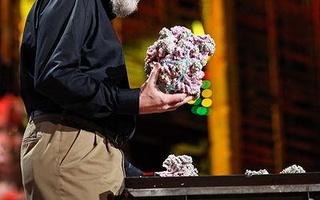
Labeled DNA samples appear as multi-colored barcodes under fluorescent light at certain wavelengths. Harvard scientists at the Wyss Institute recently published their findings in “Nature Chemistry.”
Thanks to the recent findings of a team of Harvard researchers, scientists can now view more than four microspecies at once using fluorescent microscopy—a development which will give scientists a fuller understanding of the samples they are examining.
On Monday, a team led by Peng Yin, William Shih, and George Church, all core faculty members at Harvard’s Wyss Institute for Biologically Inspired Engineering, published their work online in the journal “Nature Chemistry.”
Prior to this new research, scientists using fluorescent microscopy, which uses fluorescent light at a certain wavelength to make microspecies visible, could only assign a microspecies one color: either red, blue, or green, and sometimes yellow. Now, researchers will be able to assign multiple colors per sample. Labeled microspecies will look like multi-colored bar codes.
According to Yin, his team found 216 different possibilities of the colored spots’ arrangement, which could identify and locate different cell types, molecular structures, and parts of a cell. These barcodes have significant implications for the imaging community.
The finding will also affect the biomedical technology community as using multiple colors will facilitate DNA origami, a process that allows researchers to bend and bind DNA to other molecules.
“We can essentially use DNA joints to assemble the nanostructures into long rods, and we can modify the rods with fluorescence at different locations. We then use these tiny rods to arrange the fluorescent spots into colorful barcodes. Basically now using three or four colors, we can have hundreds of different barcodes,” said Yin.
DNA origami is an important and “wonderful tool,” said Yin, who began to study and develop the technology in the spring of 2010, shortly after he joined the Wyss Institute.
“We’re moving fast in our ability to manipulate DNA molecules using origami technology,” Wyss Institute Founding Director Don Ingber wrote in a press release.
“The landscape of its potential is tremendous—from helping us to develop targeted drug-delivery mechanisms to improving the scope of cellular and molecular activities we are able to observe at a disease site using the latest medical imaging techniques,” he wrote.
Although the research team published their findings, the fruit of years’ worth of labor, the scientists hope to further develop this technology to make it more compact. They are considering different barcoding structures as well.
Read more in News
Harvard Seeks To Dismiss Cosby Civil SuitRecommended Articles
-
 Behind the Bamboo Curtain: Students Hop Over to Pyongyang
Behind the Bamboo Curtain: Students Hop Over to Pyongyang -
Karthinking About PartyingThis week—with my last column ever—I’d like to Karthink about my morally hazardous justification for the benefit of my similarly hesitant peers: Partying all May will make you live longer.
-
Group for Women in Computer Science is RebornThe long-dormant organization Women in Computer Science returned to Harvard this spring.
-
 Crimes at Harvard and Wartime House Life
Crimes at Harvard and Wartime House Life -
 George Church Visits Colbert
George Church Visits Colbert -
Harvard Scientists Discover New Method for Creating Biological PolymersProfessor David R. Liu ’94 and coworkers have reported a new synthetic method of directly building polymers by reading the genetic code off of DNA. According to Liu, this method could eventually lead to the discovery of useful new biological compounds.













